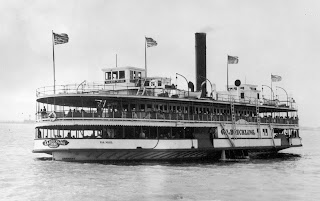 |
| Sandusky Standpipe Crushed by Tornado Courtesy of Sandusky Library |
On a warm Saturday afternoon in late June 1924, a light rain began falling. Blue-black clouds gathered over Lake Erie's Sandusky Bay. The winds, coming from the southeast, suddenly swung to the northwest and increased rapidly to gale force. Sandusky's 23,000 residents had no idea that within minutes they would be engulfed by Ohio's deadliest tornado.
Sandusky Yacht Club. ca. 1910
Following the tornado, no part of the yacht club was ever found
Rutherford B . Hayes Library and Museums
Following the tornado, no part of the yacht club was ever found
Rutherford B . Hayes Library and Museums
Located on the eastern edge of what has come to be known as "tornado alley," Ohio experiences an average 16 tornadoes each year. While tornadoes can occur in any month and at any time of the day or night, the peak season runs from April through July, with the bulk of twisters hitting between 2 P.M. and 10 P.M.
Tornado Alley
Tornadochaser.com
Tornadochaser.com
By this definition, the tornado that touched down at the northern edge of Sandusky on the afternoon of June 28, 1924 fit the classic mold. While it was neither the largest nor the strongest tornado to hit Ohio, it was the deadliest. What set this one apart from the others? It was the twister's destructive path through populated areas.
At the Cedar Point dock, 1,200 passengers aboard the "Boeckling" looked on in horror as the twister tore apart the waterfront.
Cedar Point
Nine city blocks bounded by Adams Street, Market Streets, and Washington Park were damaged. By the time the tornado headed out into Lake Erie, it had killed eight Sanduskians and destroyed more than 100 homes and 25 businesses in the city.
Cedar Point
Lake Erie's Yesterdays
Nine city blocks bounded by Adams Street, Market Streets, and Washington Park were damaged. By the time the tornado headed out into Lake Erie, it had killed eight Sanduskians and destroyed more than 100 homes and 25 businesses in the city.
Tornado's Path
Courtesy of Cleveland Memory
Courtesy of Cleveland Memory
The deadly funnel then came down at Cedar Point. Shortly after 5 P.M., it roared ashore at Lorain's Lakeview Park ripping a three-mile path of death and destruction through the city's downtown. The grim tally in Lorain was 72 people killed, 500 homes destroyed, and another 1,000 damaged. Fifteen bodies were found among the wreckage of the State Theater and another eight were discovered in the collapsed Bath House. Cars were blown into Lake Erie and nearly every downtown business sustained damage. The freighter "Henry Ford II," under construction at the American Shipbuilding yards, broke its moorings and rammed a bridge on the Black River pushing it four feet off its foundation.
The National Guard, Salvation Army, Red Cross, and search and rescue teams made up of ordinary citizens worked through the night to locate the missing and injured. Doctors and nurses came from Clevcland, Ohio to treat the injured. But it would be weeks and weeks before life in the two cities returned to anything that resembled a normal existence.
No one knows the exact number of human lives lost that deadly day in 1924, but 85 has become the accepted figure. The so-called "Lorain-Sandusky Tornado" ranks 22nd on the nation's list of the 25 deadliest tornadoes. It remains the only Ohio tornado to make that infamous list.
Less than a year later, the Midwest would experience the nation's deadliest twister. The "Tri-State Tornado" took the lives of 695 people along a 220-mile track through Missouri, Indiana, and Illinois. Since then education, better forecasting, communication and construction techniques all have helped lessen the deadly impact of a tornado. However, tornadoes continue to be nature's deadliest phenomenon.
____________________________________________
Note: See the excellent "Sandusky History" blog for more details and photos.
The National Guard, Salvation Army, Red Cross, and search and rescue teams made up of ordinary citizens worked through the night to locate the missing and injured. Doctors and nurses came from Clevcland, Ohio to treat the injured. But it would be weeks and weeks before life in the two cities returned to anything that resembled a normal existence.
No one knows the exact number of human lives lost that deadly day in 1924, but 85 has become the accepted figure. The so-called "Lorain-Sandusky Tornado" ranks 22nd on the nation's list of the 25 deadliest tornadoes. It remains the only Ohio tornado to make that infamous list.
Less than a year later, the Midwest would experience the nation's deadliest twister. The "Tri-State Tornado" took the lives of 695 people along a 220-mile track through Missouri, Indiana, and Illinois. Since then education, better forecasting, communication and construction techniques all have helped lessen the deadly impact of a tornado. However, tornadoes continue to be nature's deadliest phenomenon.
____________________________________________
Note: See the excellent "Sandusky History" blog for more details and photos.





No comments:
Post a Comment